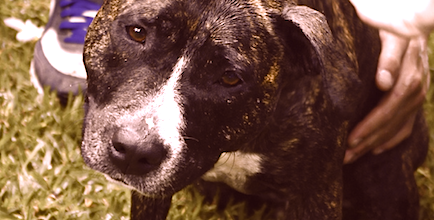Jaundice in Dogs: Why Some Dogs Turn Yellow
Jaundice in dogs isn’t always a sign of liver disease. Here’s some information on what your dog turning yellow could mean.

You notice your dog turning yellow. Do you jump to conclusions?
This was the case for the people who brought their dog in last Friday night (challenging cases always happen on a Friday).
He was a Cocker Spaniel who doddered into the consult room looking at least 100 years old. It turned out he was only 8, but he hadn’t been himself for several days. His case is an example of jaundice in dogs.

Don’t leave your pet’s safety to chance
Sign up for Petful recall alerts today.

What is Jaundice in Dogs?
Jaundice is a medical condition, also known as icterus, that is characterized by skin, gum, and eyes taking on a yellow hue due to elevated levels of bilirubin. Other signs of jaundice could be mistaken for regular illness, such as fever, vomiting, diarrhea, changes in behavior, and more. If you notice your dog showing signs of jaundice, take them to a vet for a proper diagnosis of the underlying cause.
Physical Exam
With this case, within seconds it became evident that the whites of this dog’s eyes were stained yellow. After lifting his lip, I wasn’t surprised to see that his gums were not pink but yellow, and on parting his fur I saw his skin had a yellow tinge. This dog was jaundiced.
His concerned humans had been watching my face and quickly demanded to know what I’d seen. Learning their dog was jaundiced, the mother immediately said, “That’s his liver, isn’t it?”
Most people jump to the conclusion that liver disease is the sole cause of jaundice, but it’s actually more complicated than that.
Possible Causes of Jaundice in Dogs
The yellow staining of jaundice is caused by an excess of bilirubin in the bloodstream. The big question? How did the bilirubin get there?
This is where liver disease comes in: The liver processes bilirubin to form bile, so any condition that causes liver cell destruction releases bilirubin into the bloodstream.
The most common types of liver disease are:
- Infection, either bacterial or viral (what we call “hepatitis”)
- Toxins, such as poisonous plants or toxic chemicals
- Breed-specific liver disease, such as copper toxicosis in Bedlington Terriers
- Autoimmune disease, where the immune system attacks its own cells
- Cancer
- Adverse drug reactions
From the range of problems, you can see why using the label “liver” disease is pretty general. Treatment of jaundice in dogs depends on identifying the exact nature of the liver disease.

But this is only part of the story because jaundice can arise from problems that occur before blood circulates through the liver or because of problems with bile as it exits the organ. This is what vets call pre-hepatic, hepatic or post-hepatic jaundice.
To understand this concept, think of the bilirubin in the bloodstream like cars on a road. When everything flows properly, there’s no problem. Now imagine there’s a massive traffic jam to get onto the freeway. It may be caused by a breakdown on the road (pre-hepatic jaundice), or only one lane is open on the freeway (hepatic jaundice) or an accident occurred on the off-ramp (post hepatic).
Problems Before the Liver
Pre-hepatic problems are due to the destruction of red blood cells, which sets bilirubin free. The most common reasons for this include:
- Parasites
- Heartworms
- Autoimmune disease
- Cancer
- Adverse drug reaction
Treatment varies widely, depending on the cause, and ranges from high doses of steroids (autoimmune disease) to surgery or chemotherapy.
Problems After the Liver
Just like that accident on the freeway off-ramp, anything that prevents the gall bladder from draining out of the liver will cause bilirubin to build up in the liver and then overflow into the bloodstream.
The most common causes of this are:
- Gall bladder disease, such as gallstones or infection
- Pancreatitis
- Cancer
- Trauma to the belly
Again, identifying the exact problem is crucial to correcting the jaundice.
Here’s Dr. Bob Payne, DVM, with more info in this quick video:
Identifying the Problem
So how does your vet know where the problem lies? Good question — it depends on running diagnostic tests.
A physical examination clues the vet in on body condition, fever or cancer but goes only so far. Blood tests are therefore necessary.
Screening blood tests help identify anemia (lack of red blood cells), raised white cell counts (sign of infection or cancer depending on the type) and liver enzymes. This gives pointers as to where the problem lies, but still further work is needed.
Anemia could be due to red blood cell destruction, and so the vet runs tests on the blood itself. This means looking at the blood cells under a microscope for changes consistent with cancer or autoimmune disease. In addition, they may run an “auto agglutination test” to see if the blood cells are sticking to themselves (a sign of autoimmune disease).
After that, imaging such as X-rays or an ultrasound scan helps troubleshoot for tumors. If it appears the liver is the site of the problem, then a needle biopsy gives a definitive diagnosis.
As it happened, my patient on Friday night had a liver infection, so the mother was right all along — but I’d call it a lucky guess because jaundice is far more complicated than just “liver” disease.
Frequently Asked Questions (FAQ)
Is Jaundice in Dogs Contagious?
Jaundice itself is not contagious, as it is a symptom of an underlying issue. It’s possible that whatever specifically causes a given dog’s jaundice may be contagious, so it’s good to ask your vet.
What Does Jaundice Look Like in Dogs?
In dogs, jaundice can be characterized by the yellowing of a dog’s eyes, gums, or skin, along with other illness symptoms. If you notice your dog turning yellow, or they begin exhibiting symptoms of illness, consult with your vet as soon as possible to determine their diagnosis.
Why Are My Dogs Eyes Yellow?
This could be from jaundice, and is likely being caused by underlying health issues. If you notice your dog’s fur turning yellow, or their eyes yellowing, contact your vet right away to determine the cause of this so they can begin treatment.
This pet health content was written by a veterinarian, Dr. Pippa Elliott, BVMS, MRCVS. It was last reviewed Oct. 11, 2018 and updated on June 17, 2024.








